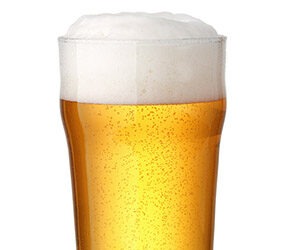Using Spunding Valves
All-grain homebrewers with temperature-controlled fermentation capabilities have most of the same levers to pull as craft brewers, but fermentation pressure is one notable exception. And pressure is exactly what a spunding valve (spundapparat in German) allows you to control. Spunding valves regulate the pressure inside a keg or pressure-rated fermenter, venting carbon dioxide in excess of the set point. This extra lever comes in handy for a whole range of brewing techniques, from adjusting carbonation, to applying pressure to alter ester production, to holding in dry hop aromatics.
Carbonation
The most traditional use for a spunding valve is natural carbonation. German brewers bound by the Reinheitsgebot, and thus not permitted to prime with refined sugar or pump in manufactured CO2, developed various carbonation techniques. Two of these tactics, kräusening and adding speise, require dosing a calculated amount of malt- derived fermentables late in the process (young beer for kräusening, wort in the case of speise). Spunding achieves similar results but works differently, trapping the carbon dioxide produced during the tail of fermentation. The most modern method, impractical for all but the most dedicated homebrewers, is to capture and pressurize CO2 off-gassed during fermentation to use in force carbonation.
Spunding doesn’t strictly require a spunding valve. To accomplish the same result, you could execute a forced fermentation test to determine the final gravity (FG) of the beer; monitor the gravity until it reaches 0.002–0.004 above the FG, then transfer the beer to a keg. Fermentation generates 0.5 volumes of CO2 for every 0.001 gravity reduction, building upon the temperature-dependent CO2 saturation from fermentation at atmospheric pressure.
A spunding valve provides latitude by venting excess CO2 once the beer reaches target carbonation. Rack to a keg (ensuring there is space between the beer and gas dip tube), add a few PSI of CO2 to ensure the lid seals, and set the spunding valve based on the temperature and desired carbonation using a reference chart. Pressure will be substantially higher than you are accustomed to for force carbonation as a result of the warmer temperature required for yeast activity. Once the pressure stabilizes, remove the spunding valve and allow the yeast a few extra days to clean up before chilling and tapping!
I’ve never read (or tasted) any proof that natural carbonation produces “finer” bubbles than force carbonation; once dissolved, CO2 is CO2. The same goes for head quality, so long as the beer is not foamed during the carbonation process (see “Mr. Wizard” from December 2016, available online here: https://byo.com/mr-wizard/carbonation-size-mr-wizard/). However, relying on the yeast for carbonation is not without benefit. Spunding allows yeast to scavenge oxygen introduced during kegging to a level below what is possible simply by purging the keg with CO2 prior to filling.
A spunding valve is also handy for de-carbonating. Vent off excess pressure from an overcarbonated keg by attaching your spunding valve and setting it to the desired pressure and wait rather than guessing how many times to pull the pressure release. Keg-conditioning with hyper-attenuative Brettanomyces is another handy time to make use of a spunding valve.
Pressurized Fermentation
Pressure alters the byproducts of brewer’s yeast fermentation and thus the resulting fermentation character. This phenomenon is one of the reasons for fermenter geometry being so important for commercial breweries. The taller the wort column, the more hydrostatic pressure is exerted by gravity, holding more CO2 in solution. While the difference between 30 feet (9 m) and 60 feet (18 m) fermenters is significant (an increase from 13.5 to 27 PSI on the wort at the bottom), there isn’t a similar influence on a homebrewing scale where the discrepancy from 1.5 feet (0.45 m) to 3 feet (0.9 m) is less than 1 PSI.
A spunding valve is the easiest way for homebrewers to influence fermentation with pressure. Adding pressure is done by some lager producers to suppress esters, allowing a warmer/quicker fermentation without increased fruitiness. One study found that increasing the top-pressure from 1.05 bars to 1.8 bars (15 to 26 PSI) cut the production of ethyl acetate (pear or solvent) and isoamyl acetate (banana) by a lager strain in half at both 50 and 60 °F (10 and 15 °C). At 60 °F (15 °C) and 26 PSI the esters were substantially lower than at 50 °F (10 °C) and 15 PSI, suggesting pressure as a possible solution for brewers without access to ideal lager fermentation temperatures. Pressurized fermentation is less beneficial for Belgian and English styles where esters are desirable (and one reason squat open fermenters are traditional in these countries).
If you are fermenting in a 5-gallon (19-L) keg, you’ll need to brew an undersized batch. This may also be a good time to add a few drops of anti-foam (e.g., Fermcap-S) to prevent kräusen from climbing into the spunding valve (preventing pressure from escaping during primary fermentation is dangerous given the immense CO2 production).
After pitching the yeast, set the spunding valve to 15–25 PSI and allow fermentation to proceed. Pressure lowers yeast growth, so allow pressure to build as fermentation progresses without fully pressurizing the keg with CO2 from the start. (You may need to add a few PSI to ensure the keg lid seals initially.)
Dry Hopping Under Pressure
Holding in pressure during dry hopping is one of the newest and most interesting applications for a spunding valve. I’ve found my IPAs improved immensely once I started dry hopping before fermentation ends. This approach helps to scrub any introduced oxygen, and encourages interactions between the yeast and hops (see “The Science of Hop Glycosides: Hop aroma buried under your nose” in the July-August 2015 issue of BYO). The problem is that any CO2 that leaves the beer carries hop aromatics with it, just like the bubbles in a glass of beer carry aromatics into your nose. The invariable truth is that if your basement smells citrusy after dry hopping, volatile hop oils are in the air and not in your beer!
The benefit of dry hopping under pressure was first brought to my attention by JC Tetrault of Trillium Brewing Co. At home, you can transfer a beer to a keg while it is 0.004–0.008 above your expected FG with the first dose of dry hops. I bag and weight whole hops placing them into the keg before purging with CO2. While the yeast will scavenge oxygen, the less available oxygen the better. The ultimate set-up would be a keg with a fine mesh screen over the dip tube allowing more complete contact between wort and hops; once the desired hop aroma is achieved serve as is, or jump the beer to a CO2 purged serving keg.
Assembling a Spunding Valve
There aren’t any commercially available spunding valves for Corny kegs, so if you want one, you’ll have to put one together. I used plans available from HomeBrewFinds.com (https://www.homebrewfinds.com/2020/08/control-devices-adjustable-pressure-relief-valve-0-to-100-psi-10-59-free-prime-ship-building-a-spunding-valve-2.html) at a total cost of about $30. BYO also included detailed plans to build a spunding valve with a different look in the January-February 2007 issue, which is available for download at https://byo.com/product/rebuild-keg-spunding-valve/. Whatever the design you choose to go with, it should include four key pieces:
- A gas quick disconnect (this will attach to the pin or ball-lock gas post)
- An adjustable valve (to set the pressure)
- A pressure gauge (to monitor the pressure)
- Something to attach the first three items together
The markings on these small valves are notoriously unreliable, so trust the gauge to be more accurate.
After assembly, leave the valve attached to a pressurized keg for 24 hours to ensure it doesn’t leak. Once you know the spunding valve is properly assembled, you can use it to test kegs for faulty seals.
A spunding valve isn’t a necessary accessory, but it provides another point of control to help you produce perfectly carbonated beers, cleaner lagers, and hoppier IPAs!
References:
• Landaud, S., Latrille, E., & Corrieu, G. (2001). Top Pressure and Temperature Control the Fusel Alcohol/Ester Ratio through Yeast Growth in Beer Fermentation. Journal of the Institute of Brewing, 107(2), 107-117. http://onlinelibrary.wiley.com/doi/10.1002/j.2050-0416.2001.tb00083.x/epdf
• http://scottjanish.com/fermenting-dry-hopping-pressure/




